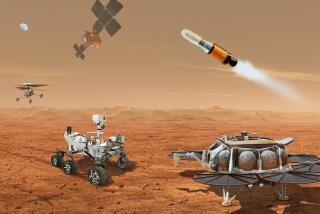A Renewed Interest in Exploring Mars
So why explore a wasteland? Ten years ago this week the first of two Viking spacecrafts landed on Mars, shattering centuries of speculation about the existence of intelligent aliens. The data relayed back indicate that Mars is as dead as the moon.
The absence of life on Mars hit many space buffs like a splash of ice water. According to Caltech’s Norman Horowitz, who led the bioscience section for the Viking missions, “We have awakened from a dream. We are alone,” and once we acknowledge our uniqueness in the solar system, perhaps in the galaxy, we should “increase our resolve to avoid self-destruction.”
Technology Explodes Myths
In his newly published “To Utopia and Back” (W. H. Freeman), Horowitz describes the Viking missions as the final confrontation between myth and technology, and the subsequent death of the myth. Myths had Mars crisscrossed with canals and dotted with the remnants of an ancient civilization. Whatever may ultimately be found there, Mars is without doubt far less hospitable to organic, carbon-based life than even Antarctica, the coldest, driest place on Earth. Moreover, according to Horowitz, Mars was not only devoid of life at the two landing sites, but the entire planet is incompatible with organically based life because there is no water, and there is too much short-wavelength ultraviolet radiation.
Although Viking amassed an enormous amount of information about the Martian climate and atmosphere, the absence of life punctured the enthusiasm of the momentum to pursue further exploration.
That momentum is back. Some scientists are not yet convinced that Viking told the whole story. In a recent article in the Journal of the British Interplanetary Society, Benjamin Adelman said that while it is true that no water was found on the surface of Mars (and all cells need an aquatic solution), the landers had no instruments to seek underground water. Nor were there instruments that could determine precisely whether hydrogen, oxygen or nitrogen were present in the samples, nor could they measure the intensity of the ultraviolet flux on the Martian surface. Adelman urges exploration with cameras as well as chemistry tests.
Even without evidence of life, Mars is no moon. It is a planet with an atmosphere, polar caps, ridges and valleys that reveal a long geological and climatological history. It is the only other body in our solar system that offers us a chance to study the planetary evolution where change has occurred without the interference of intelligent life.
Mars is a museum of its own past, with formidable evidence that at some ancient time there was indeed water and a very different climate. As such, it can provide information about the Earth’s origin as well as hints of what may lie in our future. What it may offer in the way of possible sites for exploitation, aside from what is intellectually challenging, is hard to gauge. It may be that the exploration of Mars can be important to our civilization on Earth even without some dollar return on our investment.
The Challenger tragedy changed the focus of the U.S. space program. Bruce Murray, the former director of Jet Propulsion Laboratory and currently professor of planetary science at Caltech, believes Americans will never again risk human lives to do things unmanned vehicles can do. At the same time, our deep national mourning underscores a profound commitment to a human presence in space.
Mars calls out for a manned mission. After preliminary probes have analyzed the atmosphere, only human imagination and ingenuity can conduct in depth a planetwide exploration. Murray suggests that a manned voyage to Mars can be planned economically and have vital international implications for peace, especially if we prepare such a mission jointly with the Soviets.
Missions to Martian Moons
Today, a decade after Viking, Mars beckons with renewed urgency. The Soviets have already planned two unmanned missions to Phobos, one of the two Martian moons, for 1988 and 1994. The Soviets may plan a mission to the planet itself whether we plan one as well.
The executive order that enabled the United States and the Soviet Union to cooperate in earlier space ventures expired after Viking in 1982. Since then what cooperation there has been has followed personal lines of communication with little official recognition. Plans for new summit talks suggest that both nations may be ready to work together again. These are precarious times, but these are also times of promise. As negotiations for a summit continue amid the rumble of threats of Star Wars and missile deployment, space scientists in both nations continue to hum softly of the political as well as the economic and scientific advantages of a joint mission.
It is likely that the first life on Mars will be human life. Let us pray that it will arrive in a civilian vehicle representing an international delegation.






